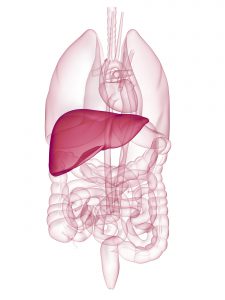The role of the liver
The liver

Where is it in the body?
It is located on your right side, midway between your waist and your arm pit.

Composition and how it works
The liver is composed of a left and right lobe. The gallbladder is located at the right lobe and stores the bile.
Two distinctive sources bring blood to the liver: the hepatic artery, which brings blood coming from the heart, and the portal vein that brings blood from the intestines. Then the hepatic veins eliminate/drain that blood.
The liver under the microscope
If we look closer, the liver is composed, of lobules where we find blood vessels, canals and cords interposed by liver cells, hepatocytes , which act as exchange zones.



What is the use of the liver?
As the largest organ in our body, our liver has 3 vital functions, essential to our body: detoxification, synthesis and storage.
Detoxification
Real filter, the liver recovers and eliminates many toxins. Those toxins can be naturally present in the waste generated by our organism, like ammonia, or in the ones we eat or drink, like alcohol.
Synthesis
Our liver assures the metabolism of the carbohydrates, the fat and the proteins while producing bile, essential element for our digestion. Our liver also avoids hemorrhages via the coagulation process.
Storage
The liver stores vitamins (A, D, E, and K) and glycogens (carbohydrates) meaning it stores energy like sugar and makes it available to our organism when needed.
Want to test your knowledge about the liver? Make the quiz!
Which one of these sentences is correct about the liver ?
The liver can regenerate itself, and is vital for us. It approximately measures 10cm of length.
How much does it weight?
Indeed, the liver weights little more than 1.5kg.
Where is it located in the body?
Important if you need to do a liver exam : remember that it is located on your right side, contrary to the heart. 
What is the liver for?
These are its three vital functions: to eliminate toxins (especially the ones found in alcohol), to insure some metabolisms (carbohydrates, lipids and proteins), and stock the energy under the glycogen form.
What are hepatocytes?
Hepatocytes are not enzymes, nor synthesized carbohydrates, but the main liver cells. They represent between 70% and 80% of them.* *Si-Tayeb K, Lemaigre FP, Duncan SA, « Organogenesis and development of the liver »
Which of these functions is not performed by the liver?
As we mentionned before, its three main functions are : toxins purification, nutrient synthesis, and energy storage.
Share your Results:

